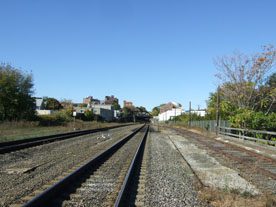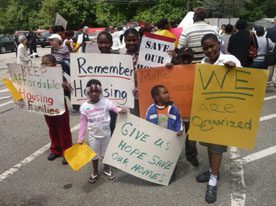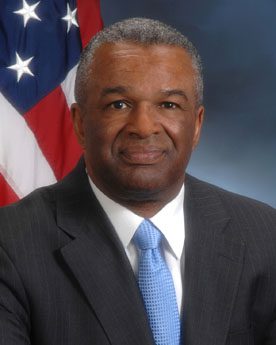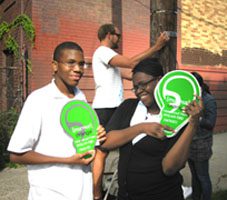
Uphams Corner, part of Boston’s Dorchester neighborhood, is a key part of a collaborative effort to improve transit access.
In 2007, the Somerville Community Corporation (SCC) was glowing in the wake of a major victory. They had just negotiated an agreement with IKEA, the trendy furniture chain, guaranteeing a share of the jobs in the company’s new store for residents of the city. The store was coming to Somerville, just north of Boston, to locate next to a brand-new subway station on the Orange Line. SCC thought the transit was great, but saw the jobs as the most important thing. The agency’s priority was to make sure its low-income and immigrant constituents had something to gain.
Meanwhile, a much bigger transit campaign was well underway in another part of the city. For decades, transit advocates had been fighting for more train service for Somerville, one of the most densely populated cities in the country. They had won a commitment two years earlier from the state of Massachusetts to build six new stations along an extension of the Green Line, and were now focused on how property adjacent to these stations would be developed. Unlike the stop next to the IKEA store, which was isolated from most of the city’s population by an interstate highway, the Green Line stations would be located in places where homes and businesses had historically been concentrated. Indeed, over half the households in the city live within a half-mile of one of the six new stops.
“The people who study land use associated with rapid transit say you can expect major changes within a half-mile of the stops,” says Daniel LeBlanc, SCC’s executive director. “We said, ‘Wow, the biggest thing that’s going to happen here is the Green Line.’”
LeBlanc and his colleagues at SCC knew what had happened when a third subway, the Red Line, was extended to West Somerville in the 1980s. Within two decades, virtually the entire working-class population that had lived in that part of the city for generations disappeared. They were replaced by a wave of wealthier professionals drawn to the easy transit access into Boston. SCC was convinced the same thing would happen on the Green Line if it didn’t launch a vigorous campaign against displacement.
But SCC didn’t want to appear to be thwarting the ambitions of transit advocates by suggesting that new subway service was a bad thing. So the CDC asked these advocates to join them in a coalition dedicated to achieving equitable transit-oriented development. Over the past two years, SCC has worked closely with several partner organizations to plan a vision for development that includes working-class groups, rather than shutting them out.
Meanwhile, activists in Dorchester’s Four Corners section began pushing in 1999 for new stations on the commuter rail line that runs through their section of Boston. It was a matter of fairness: why should suburban commuters have access to rapid transit but not people in low-income city neighborhoods of color? The Fairmount Line carries riders from the southern end of the city to downtown with just three stops in the tightly packed neighborhoods in between. Moreover, service is limited even at those stops. Supporters call their vision of enhanced transit the Indigo Line, to suggest that their line should be part of the subway system that has long served other, whiter or wealthier parts of Boston.
As in Somerville, a coalition of CDCs and transit activists from the Dorchester, Mattapan, and Hyde Park sections of Boston has formed around the Indigo Line transit campaign to both seek development and at the same time caution against its side effects and to push for increased service, but without displacement. In both cases, these dynamic coalitions have their challenges and risks, but members say they also bolster their individual strength. CDCs, as developers and groups not historically at the center of transit fights, bring an important voice to these endeavors.
The Indigo Line
In 2004, four CDCs in Mattapan, Hyde Park, and Dorchester’s Uphams Corner and Codman Square launched a collaborative to coordinate their efforts around mixed-income housing development, access to jobs that pay a decent wage, and civic engagement. While they didn’t join the Indigo Line bandwagon as quickly as other activist groups in the area, they were quick to do so once they connected the potential of transit-oriented development with their existing goals. Many of the vacant or underused lots their neighborhoods are located adjacent to the commuter rail line in places where the line intersects major avenues. These lots have long been ripe for development, but the prospect of train stations at these locations created tantalizing new development opportunities for the CDCs and a chance for their neighborhoods to create stronger centers of activity.
To move forward, the CDCs and transit advocates realized they needed to present a united front to push the state toward a commitment to add several new stations. Later in 2004, the recently formed CDC collaborative joined the Greater Four Corners Action Coalition (GFCAC) and five other grassroots groups and nonprofits to form the Fairmount Coalition. In 2005, the state made a commitment to invest $44 million to build four new stations.
There are currently three major components to the Fairmount Coalition’s work. The CDCs emphasize dense, mixed-use development that can bring new jobs and affordable as well as market-rate housing. For example, in Four Corners the coalition is considering replacing one-story auto-oriented uses with three- to four-story buildings that have retail and housing. Most of the non-CDC partners organize residents around the issue of access to transit. Their priority has been to promote specific locations for the stations based on resident feedback. They are also pushing for appropriate station designs and frequent transit service. Meanwhile, a few partners have focused on building a greenway that will run in a narrow band along the rail corridor.
As a group, the Fairmount Coalition is committed to both good development and transit equity. Partners have had to be careful not to encroach on each other’s turf. “The key to success is to respect each neighborhood’s autonomy,” says Jeanne DuBois, executive director of the Dorchester Bay Economic Development Corporation. The coalition has a memorandum of understanding that allows for an “escalation procedure” if the group needs to break a tie vote on an issue, an option they have yet to use. They also agreed at the start to respect each partner’s right to defend its own interests, without interference from the coalition. In practice, the partners have gone beyond that to actively support each other.
Together they called for the stations to be spread out to include stops in each CDC’s territory and insisted the four stations be designed as part of a single process. In 2007, GFCAC cried foul at the state for trying to launch the design process for their station ahead of the one in Codman Square. “We asked them to do all of the sites at the same time because it just makes sense,” Marvin Martin, director of the GFCAC, told the Dorchester Reporter. “But the [state] has only released money for [Four Corners]. We said . . . that we wouldn’t entertain their ideas if we don’t know where the Codman Square station is going to be placed.”
At the same time, the coalition also had to work out a system for distributing resources equally among partners, to avoid fissures in the group. Coalition members share a fundraiser to help distribute grant funds and organize meetings. The funding that this staff member raises is distributed equally among coalition partners, although some grants are targeted at the smaller coalition members for capacity building. The coalition has received over $3 million in foundation and government grants for operating support over four years.
It’s notable that this funding has included money for all 10 partners in the coalition to hire part-time organizers. This helps lay to rest the notion that CDCs are in it for the development only and the other groups are the ones interested in equity issues. “There’s always a tension between development and organizing,” says DuBois. “But there’s a cultural value shared between us.”
To ensure community buy-in for their development plans, the four CDCs put together a planning process in 2007 that looked at growth opportunities around the four station sites. Other planning efforts have been organized within individual neighborhoods. This fall the Southwest Boston CDC and 02136, a partner organization named for the Hyde Park zip code, launched a participatory planning effort for the greenway. It will eventually link all the communities, but for now planning is at the sub-neighborhood level.
DuBois says the new Indigo Line stations will generate 1,200 new housing units, almost 800,000 square feet of new commercial space, and 1,300 new jobs. She points to exciting new projects ahead, such as a green jobs incubator and the potential conversion of a former meat packing plant to a factory for solar panels. While the CDCs are still working in many places to win site control of key parcels, she notes that Dorchester Bay EDC is beginning to apply for federal economic stimulus money on behalf of the coalition to jump-start development projects around the rail line. The money would benefit other coalition members by providing infrastructure funding for the station areas, and benefit the CDC specifically by increasing the attractiveness of adjacent properties it has developed.
The Green Line
In the case of the Green Line extension through Somerville, there is only one traditional community development organization in the coalition — the Somerville Community Corporation (SCC). The other partners include Somerville Transportation Equity Partnership (STEP), a group of transportation wonks; Somerville Community Health Agenda, a health campaign spearheaded by a local hospital; and Groundworks Somerville, which is committed to improving access to green space in one of the nation’s most crowded cities. (Groundworks, like SCC, has staff to commit to the project — the other two partners are volunteer-based.)
While all four partners support the CDC’s priority on smart TOD while preventing displacement, the other partners have their own, distinct interests. To make the coalition work as a united front, the CDC has to mute its emphasis on displacement a bit. The four partners are working together to win well-thought-out uses of the land around the station sites, as they pursue their own agendas on the side.
“If we weren’t connected to these groups we could maybe have a Right to the City message,” says Meridith Levy, director of organizing for the SCC. “If you come in with an agenda, it’s easier to be strident and reach people you know will care about that message. So our message has gotten a little watered down. We’re doing our organizing behind the scenes.”
It isn’t just the message that separates the CDC from its partners. It’s also to whom the message is addressed. “We’re trying to organize the new immigrants and the white working class,” says LeBlanc. “That doesn’t mean we don’t welcome the gentry, as long as our partners understand we’re focused on organizing the other two groups.”
Ellin Reisner, president of STEP, downplays the distinctions among the coalition members. “Our approaches are not in conflict, though they are different,” she says. “I don’t think we disagree in our overall vision.” She notes that while she only has time to focus on transportation issues when she meets with other coalition members, housing affordability is critical to her as a community resident.
SCC got involved in the Green Line issue fairly recently, in early 2008. The other three partners welcomed the CDC as part of a coalition that could push the city and state to enable smart land development adjacent to the new stations.
The partners’ central joint effort, the Community Corridor Planning Project, is a grassroots effort to get residents to plan their TOD sites in advance of the city of Somerville’s comprehensive planning process. The coalition held six visioning sessions in 2009 near each of the future stations. In October, the partners planned to bring participants together from each of the six locations to unveil principles for future development. In 2010, the next steps will be to write policy recommendations and to craft design guidelines for the six sites. The hope is that the city will incorporate much of what the coalition comes up with into the comprehensive plan.
Keeping a coalition going can create some significant challenges on a day-to-day basis. “We have more people doing the work so we can delegate to more people, and get access to more grants. But we have different staff and lines of supervision. So we have to have crisp lines of communication,” says Levy.
Getting Dollars and a Long-Term Commitment
Somerville Community Corporation and Groundworks Somerville have raised $500,000 for their planning work around the Green Line extension. The Fairmount Coalition has raised far more — some $3 million so far from foundations and government. With its holistic approach to development — transit equity, affordable housing, and green infrastructure — the Indigo Line has attracted a great deal of attention from foundations. Much of the Indigo Line money is for development purposes, not just planning. Somerville’s CDC is looking for development opportunities, too, but they are somewhat further from that stage than their Indigo Line counterparts.
In both projects, even with all this money to spend, there are few short-term results to celebrate. This is one of the biggest challenges of trying to keep a coalition together around a project that takes a decade or more to happen. The CDCs and their partners came together to work on the Indigo Line early in this decade, and they are still at least two years away from groundbreaking on new stations. Development of surrounding sites, and the greenway, could be a full decade away. Similarly, in Somerville new stations won’t be under construction until at least 2014.
The slow process can be trying for low-income residents just trying to get by. They don’t necessarily see results that affect their daily lives. While the coalition members on the Indigo Line now work closely together on transit equity and development, they don’t share programs to address issues that do come up in daily life, such as housing foreclosure and job loss, though some members do address these issues on their own, outside their work in the coalition.
Many residents were hesitant at first to get involved in the planning for the Green Line, but interest had picked up by the end of this summer’s round of visioning meetings, says Levy of SCC. The coalition formed a steering committee recently, made up of residents from the different parts of the city. The committee represents a cross-section of people who attended the meetings, including many low-income and immigrant residents.
To Reisner of STEP, getting this kind of involvement from the community is the most important thing that could have emerged from working as part of a coalition.
“The coalition’s been less involved in pushing this project to happen,” she says, noting that the state had agreed to build the stations before the coalition formed. “We came together to engage residents in what this train line is going to mean for the community, positively and negatively, and to make sure it works well.”





Comments